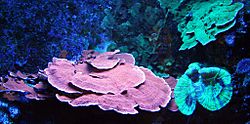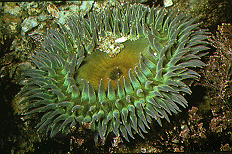Anthozoa facts for kids
Quick facts for kids AnthozoaTemporal range:
late Ediacaran to present |
|
|---|---|
 |
|
| Stony corals | |
| Scientific classification | |
| Kingdom: | |
| Phylum: | |
| Class: |
Anthozoa
|
| Subclass: | |

Anthozoa is a group of amazing sea animals that includes sea anemones and corals. They are part of a larger family called Cnidaria, which also includes jellyfish. Unlike jellyfish, Anthozoa do not have a free-swimming "medusa" stage in their life. Instead, they spend their lives as polyps, which are like small sacs attached to the seafloor or other surfaces.
Just like all Cnidaria, Anthozoa use special stinging cells called nematocysts to catch their food and protect themselves. These cells are very effective! Scientists have found and described over 6,100 different kinds of Anthozoa.
Contents
Types of Anthozoa: Subclasses
Anthozoa are divided into three main groups, called subclasses. Each group has its own unique features.
Ceriantharia: Tube-Dwelling Anemones
This group includes the tube-dwelling anemones, also known as cerianthids. These animals live inside long, soft tubes that they build in the sand or mud. They can pull themselves completely into their tubes if they feel threatened.
Hexacorallia: Six-Fold Symmetry
The Hexacorallia group is very large, with about 4,300 species. Most of these animals live in colonies, meaning many tiny polyps live together as one organism. Their bodies usually have a six-fold symmetry, meaning they can be divided into six equal parts around a central point.
- Stony Corals: This group includes all the stony corals. These corals are super important because they build the huge structures we call coral reefs. Coral reefs are like underwater cities that provide homes and food for countless other sea creatures.
- Sea Anemones: All sea anemones are also part of Hexacorallia. Sea anemones look a bit like colorful flowers, but they are animals that use their tentacles to catch small fish and other prey.
Octocorallia: Eight-Fold Symmetry
The Octocorallia group has about 3,000 species. Like Hexacorallia, these animals also live in colonies. However, their polyps have an eight-fold symmetry, meaning they have eight tentacles and eight internal divisions.
- Soft Corals: This group includes the blue coral and many soft corals. Unlike stony corals, soft corals do not build hard, stony skeletons. They are often flexible and sway with the ocean currents.
- Sea Pens: Sea pens look like old-fashioned quill pens stuck in the seafloor.
- Gorgonians: This group includes gorgonians, which are also known as sea fans and sea whips. They often grow in beautiful, branching shapes.
Images for kids
-
Deep water corals serve as habitats for fish such as the alfonsino
-
Anatomy of a stony coral polyp
See also
 In Spanish: Antozoos para niños
In Spanish: Antozoos para niños









